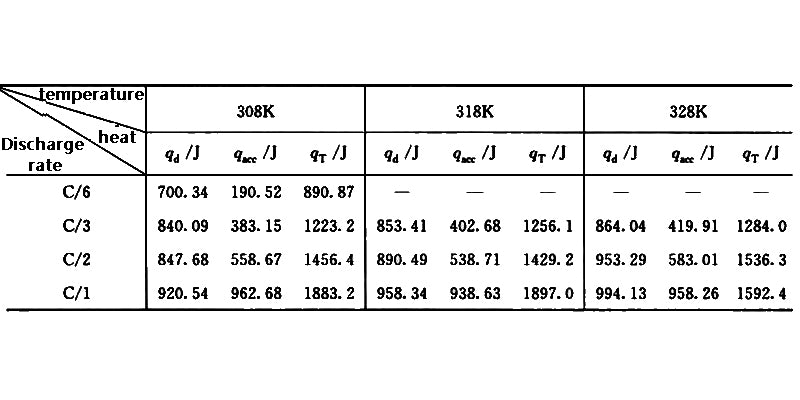电池热扩散

传递热能的基本方式有热传导、热对流和热辐射三种。锂离子动力电池的散热包括这三种传热方式,不同的散热技术侧重于某些特定的方式。热辐射主要发生在电池表面,这与电池表面材料的性能有关。用Stefan-Boltzmann定律表示为
P r (T)=εσ(T 4 -T 4 S )
式中,P r为辐射功率;ε为热发射率,对于黑体,ε=1;σ为Stefan-Boltzmann常数,即黑体辐射常数;T为电池温度,K;T s是环境温度,K。
热传导主要包括电池内部各种物质之间的热传递,如电池的电极、电解液、集流体等,即把电池看成一个整体,热量从电池内部传递电池到电池表面,用傅里叶定律表示。
qn=-k (əT/ən)
式中,qn为热流密度,W·m -2;k为导热系数,W·m -1 ·K -1;əT/ən为电极等温线法线方向的温度梯度,K·m -1。
热对流是指电流表面的热量通过热交换介质(如空气、水等)的流动进行热交换,热对流与温差成正比,用牛顿公式表示为Q=hA(
T米-T f )
其中 Q 是热通量,W;h为对流传热系数,W·m -2 ·K -1;A为面积,m 2;Tm为壁温,K;T f是流体温度,K。
对于锂离子动力电池,电池内部的热辐射和热对流影响不大,主要由热传导决定。电池本身吸收的热量取决于电池材料的比热容,电池的温升与电池材料本身的比热容成反比。
Table 1 shows the heat production qT of the 18650 type (capacity 1.35A h) Li-ion battery at different discharge rates and the heat dissipation qd at different operating temperature ranges, where qacc is the heat absorbed by the battery itself. It can be seen that the heat of the battery is used to increase its own temperature because the heat dissipation is not timely, resulting in an increase in qacc. Therefore, through the heat dissipation of the battery, increasing the value of qd and decreasing the value of qacc can reduce the internal working temperature of the battery.

Table 1 Heat generation and heat dissipation behavior of 18650 Li-ion battery